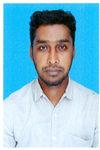
Mohammed Yahoob Syed Ali
Mohamed Sathak College of Arts and Science, India
Title: Antiplasmodial activity of biosynthesis nanoparticles from seaweeds Plasmodium falciparum
Biography
Biography: Mohammed Yahoob Syed Ali
Abstract
Malaria is one of the most prevalent infectious diseases in the world. Treatment for malaria is commonly inadequate due to the lack of quality assured effective drugs. The effectiveness of these drugs is declining at an ever accelerating rate with consequent increase in malaria related morbidity and mortality. The newest antiplasmodial drug from plants is needed to overcome this problem. The seaweeds species are a good source of bioactive entities which exhibits many therapeutic properties. The present study was carried out to test the antiplasmodial activity of three seaweeds species distributed along the South East coast of India. Biosynthesis silver nanoparticles from Sargassum sps Caulerpa taxifolia and Dictyota dichotoma plant exhibited in vitro antiplasmodial activity against Plasmodium falciparum. Of which, the nanoparticles of D. dichotoma exhibited high antiplasmodial activity (IC50=60.11 μg.ml−1). Statistical analysis reveals that, significant antiplasmodial activity (P<0.05) was observed between the concentrations and time of exposure. The chemical injury to erythrocytes was also carried out and it shows that no morphological differences in erythrocytes by the synthesized nanoparticles of seaweeds after 48 hours of incubation. The FTIR results of most potent leaf extract-synthesized silver nanoparticles showed the prominent peaks (range between 620.967 to 2,854.14) Further, the results of XRD analysis showed the 2 hours intense values (38.11 and 70.57) within the ranges of Bragg’s reflection. In addition, the SEM analysis showed the results of particle sizes (50-100 nm). This study shows that the biosynthesized silver nanoparticles had a source of lead compounds for the development of new drugs for the treatment of malaria.

